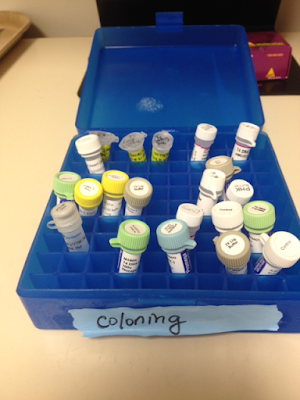One example she discussed is the abundant Spot 42 RNA, so named because it was discovered as an RNA chromatography spot long before any function was discovered. This small (109 nt) RNA acts in a feed-forward regulatory loop with the cAMP-dependent transcriptional activator CRP. This regulation fine-tunes the control of the CRP-activated genes that provide the cell with alternative carbon sources when its preferred sugars are depleted.
When the preferred sugars are available, Spot 42 RNA is expressed and limits the translation of genes for using the alternative carbon sources. Expression of these genes is already low because there is no active CRP to stimulate their transcription, and Spot 42 RNA prevents translation of any transcripts that might inadvertently get made. The contribution of Hfq (the yellow donut) is to help Spot 42 RNA interact with its target mRNAs and prevent their translation.
But when the preferred sugars run out, active CRP represses transcription of the spf gene, so Spot 42 RNA isn't made. (Yes, I know I said that CRP is a transcriptional activator, but it can also be a repressor when its binding site is on top of or downstream of the promoter.) Now the transcription that CRP stimulates produces mRNAs that are efficiently translated.
So in E. coli Spot 42 RNA improves the stringency of the regulation that we have been giving CRP full credit for.
Where does H. influenzae competence come in? Our Hfq knockout lowers competence, and the other honours student showed that this is because it makes competence more dependent on high cAMP than it usually is. So I got excited by the idea that maybe Hfq's role in competence had to do with its role in mediating Spot 42 activity on CRP-dependent transcripts. This could either be activity on CRP-dependent transcripts of the competence-specific transcriptional activator Sxy, or on the various CRP-dependent transcripts of the DNA uptake machinery.
But this falls apart in two independent ways.
First, my logic is backwards. Now that I've created these diagrams it's obvious that Hfq's contribution to competence regulation acts in the opposite direction. Knocking out hfq would be expected to increase the expression of competence genes under non-inducing conditions, not decrease it under inducing conditions.
Second, it looks like H. influenzae doesn't even have a Spot 42 homolog. Homologs are ubiquitous in the Enterobacteraceae, and have recently been shown to also be common in the Vibrionaceae, with about 85% sequence identity. But BLAST searches of the Pasteurellaceae with either type of sequence didn't find a single homolog. Given the relationships shown in the tree below. I think the ancestral Pasteurellacean must have lost its Spot 42 homolog.


























